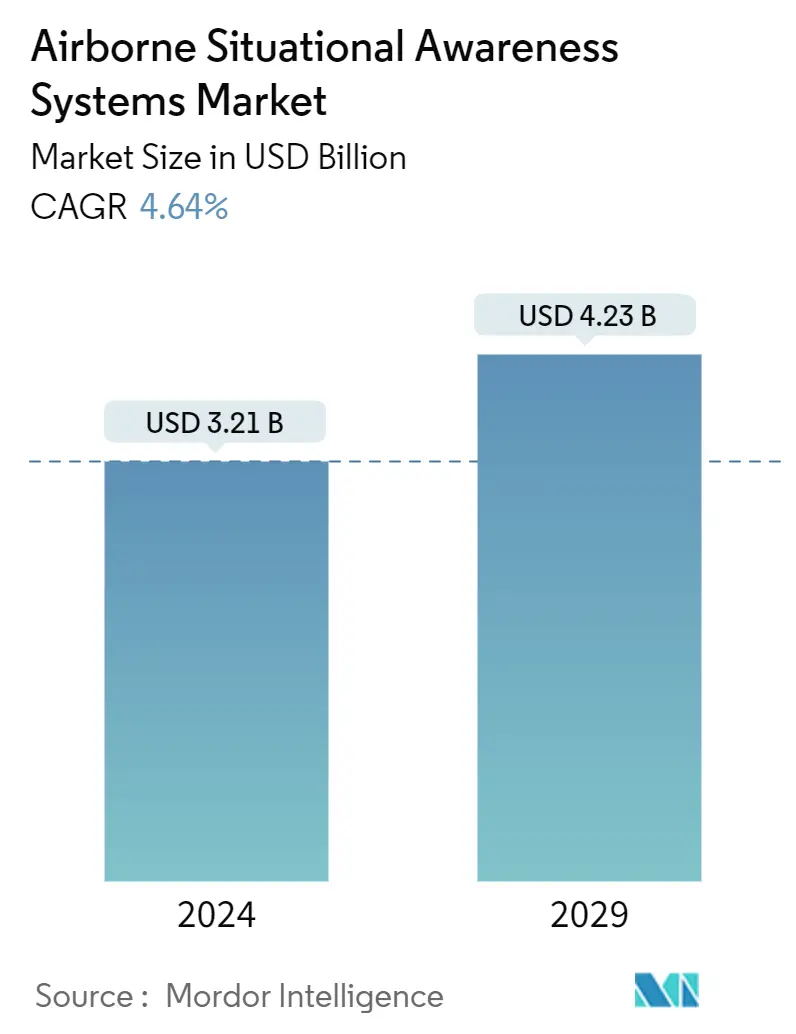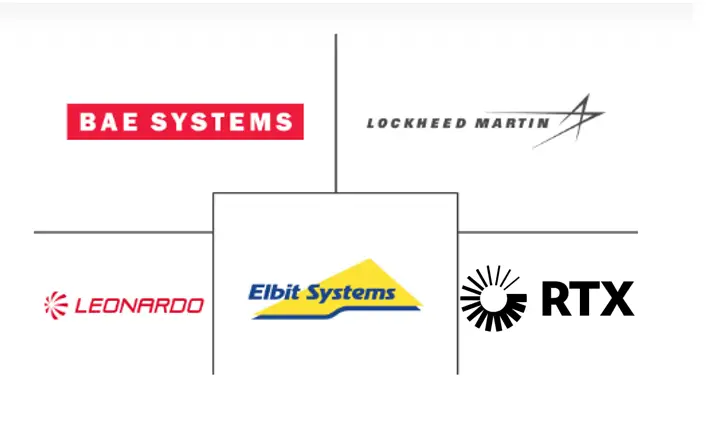Market Size of Airborne Situational Awareness Systems Industry

| Study Period | 2019-2029 |
| Market Size (2024) | USD 3.21 Billion |
| Market Size (2029) | USD 4.23 Billion |
| CAGR (2024 - 2029) | 4.64 % |
| Fastest Growing Market | Asia Pacific |
| Largest Market | North America |
Major Players
*Disclaimer: Major Players sorted in no particular order |
Airborne Situational Awareness Systems Market Analysis
The Airborne Situational Awareness Systems Market size is estimated at USD 3.21 billion in 2024, and is expected to reach USD 4.23 billion by 2029, growing at a CAGR of 4.64% during the forecast period (2024-2029).
The rise in terrorism, tensions between countries, illicit trade, border skirmishes, highly advanced anti-aircraft missile systems, electronic warfare, etc., are propelling governments to increase their military spending to raise the air superiority of their existing air force fleet for combat and intelligence and surveillance and reconnaissance operations. This factor is increasing the demand for airborne situational awareness systems across the world.
The increasing focus on miniaturization and improving the accuracy of the ISR systems and payloads are driving their utilization across all platforms. Their high reliability and availability at low costs have encouraged militaries to procure these systems in abundance. As a new line of threats emerges, these systems have become an integral part of military preparedness due to their utility.
Rapid technological developments are breeding disruptive technologies in the defense industry. The current focus is on incorporating technologies such as AI and machine learning into the airborne situational awareness systems platforms. As situational awareness is becoming critical in making decisions and acting in ISR missions, the size and volume of data and the complexity created by fusion and aggregation affect processing speeds that impair usage.
Airborne Situational Awareness Systems Industry Segmentation
North America, Europe, Asia-Pacific, Latin America, and Middle East and Africa). The Report Offers the Market Size in Value Terms in USD for all the Abovementioned Segments. Airborne situational awareness systems are the machinery used by the naval defense forces. As airborne border conflicts become more frequent, airborne situational awareness systems are used to reduce the risk of incidents. Manufacturers of airborne situational awareness systems focus on research and development (R&D) and the integration of new technologies in the airborne sector.
The airborne situational awareness systems market is segmented based on component, type, and geography. The market is segmented by components into sensors, display notification systems, and other components (notification and display systems and command and control systems). Based on type, the market is segmented into command and control, radars, optronics, and other types (high-resolution cameras and advanced data analytics software). The report also covers the market sizes and forecasts for the airborne situational awareness systems market in major countries across different regions, such as North America, Europe, Asia-Pacific, Latin America, and Middle East and Africa. The report offers the market size in value terms in USD for all the abovementioned segments.
| Component | |
| Sensors | |
| Displays and Notification Systems | |
| Other Components |
| Type | |
| Command and Control | |
| RADARs | |
| Optronics | |
| Other Types |
| Geography | |||||||
| |||||||
| |||||||
| |||||||
| |||||||
|
Airborne Situational Awareness Systems Market Size Summary
The airborne situational awareness systems market is experiencing significant growth, driven by increasing global military expenditures due to rising terrorism, geopolitical tensions, and the need for enhanced air superiority. Governments are investing in advanced systems to bolster their air force capabilities for combat, intelligence, surveillance, and reconnaissance operations. The demand for these systems is further fueled by the focus on miniaturization and improved accuracy of ISR systems, which are becoming integral to military preparedness. Rapid technological advancements, including the integration of AI and machine learning, are enhancing the capabilities of these systems, making them crucial for decision-making in complex ISR missions. The growing need for electronic warfare equipment and sensor-based radar systems is also contributing to market expansion, as countries seek to protect their airborne assets from sophisticated threats.
In the Asia-Pacific region, countries like China, India, and Japan are significantly increasing their military spending to develop and procure advanced airborne situational awareness systems. This growth is driven by geopolitical tensions and the need to enhance maritime and aerial border security. Local manufacturing initiatives and technology transfer agreements are further supporting the development of new-generation military fighters with advanced capabilities. The market is characterized by high competition, with major players like Lockheed Martin, BAE Systems, and Elbit Systems investing heavily in R&D to incorporate cutting-edge technologies. Partnerships and collaborations are facilitating technology transfer and mutual growth among industry players. The market's fragmented nature and the entry of new players with innovative solutions are expected to intensify competition and drive further advancements in airborne situational awareness systems.
Airborne Situational Awareness Systems Market Size - Table of Contents
-
1. MARKET DYNAMICS
-
1.1 Market Overview
-
1.2 Market Drivers
-
1.3 Market Restraints
-
1.4 Porter's Five Force Analysis
-
1.4.1 Threat of New Entrants
-
1.4.2 Bargaining Power of Buyers/Consumers
-
1.4.3 Bargaining Power of Suppliers
-
1.4.4 Threat of Substitute Products
-
1.4.5 Intensity of Competitive Rivalry
-
-
-
2. MARKET SEGMENTATION
-
2.1 Component
-
2.1.1 Sensors
-
2.1.2 Displays and Notification Systems
-
2.1.3 Other Components
-
-
2.2 Type
-
2.2.1 Command and Control
-
2.2.2 RADARs
-
2.2.3 Optronics
-
2.2.4 Other Types
-
-
2.3 Geography
-
2.3.1 North America
-
2.3.1.1 United States
-
2.3.1.2 Canada
-
-
2.3.2 Europe
-
2.3.2.1 Germany
-
2.3.2.2 United Kingdom
-
2.3.2.3 France
-
2.3.2.4 Rest of Europe
-
-
2.3.3 Asia-Pacific
-
2.3.3.1 India
-
2.3.3.2 China
-
2.3.3.3 Japan
-
2.3.3.4 South Korea
-
2.3.3.5 Rest of Asia-Pacific
-
-
2.3.4 Latin America
-
2.3.4.1 Mexico
-
2.3.4.2 Brazil
-
2.3.4.3 Rest of Latin America
-
-
2.3.5 Middle East and Africa
-
2.3.5.1 United Arab Emirates
-
2.3.5.2 Saudi Arabia
-
2.3.5.3 Israel
-
2.3.5.4 Rest of Middle East and Africa
-
-
-
Airborne Situational Awareness Systems Market Size FAQs
How big is the Airborne Situational Awareness Systems Market?
The Airborne Situational Awareness Systems Market size is expected to reach USD 3.21 billion in 2024 and grow at a CAGR of 4.64% to reach USD 4.23 billion by 2029.
What is the current Airborne Situational Awareness Systems Market size?
In 2024, the Airborne Situational Awareness Systems Market size is expected to reach USD 3.21 billion.

